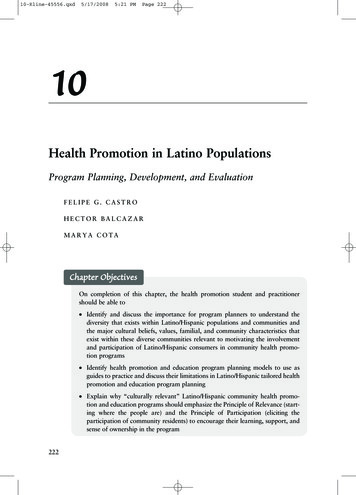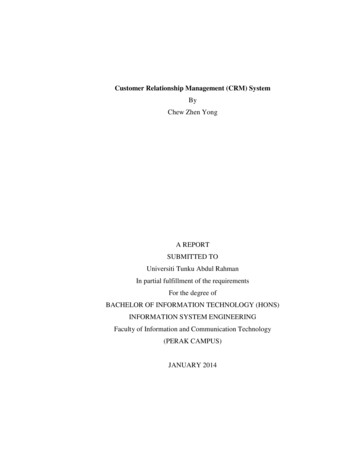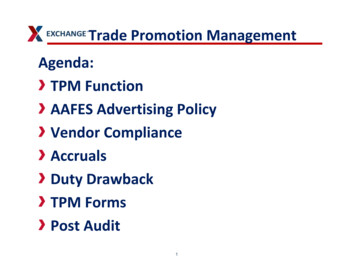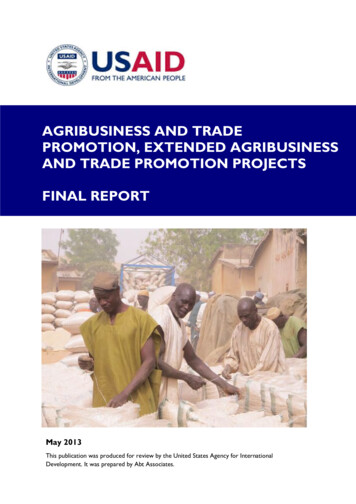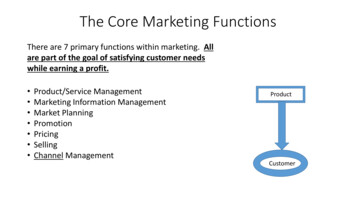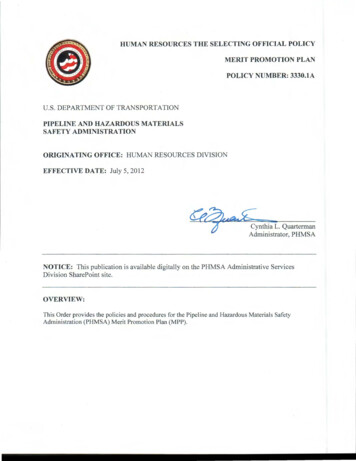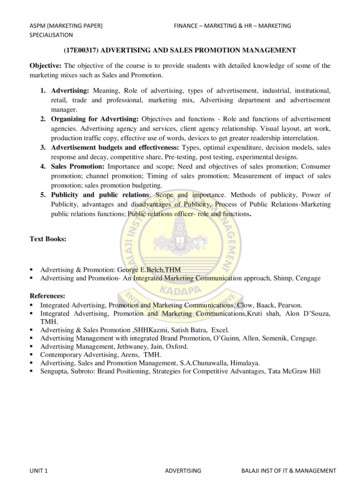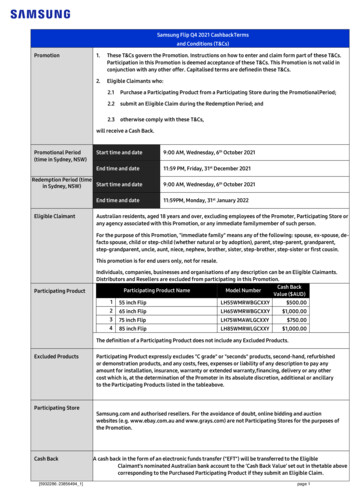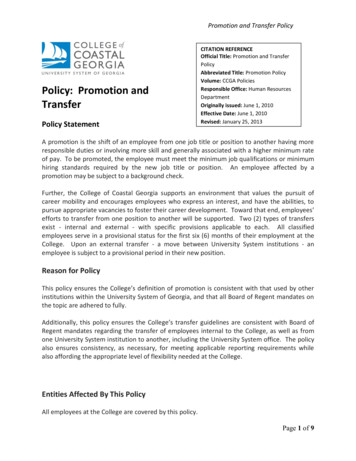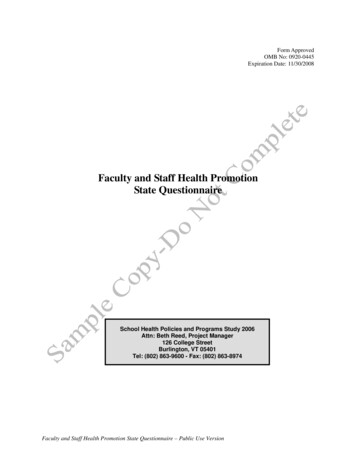
Transcription
Introduction toHealth PromotionProgram PlanningVersion 3.0, April 2001
ADDITIONAL COPIES & COPYING PERMISSIONAdditional copies of this resource are available free of charge in Ontarioonly. Please direct requests to (416) 978-0522 (phone) orhc.unit@utoronto.ca. This workbook is also available on our website athttp://www.thcu.ca.The Health Communication Unitat the Centre for Health Promotion, University of Toronto100 College Street, Room 213, The Banting InstituteToronto, Ontario M5G 1L5Tel: (416) 978-0522 Fax: (416) ssion to copy this resource is granted for educational purposes only.If you are reproducing in part only, please credit The Health Communication Unit, at the Centre for Health Promotion, University of Toronto.DISCLAIMERThe Health Communication Unit and its resources and services are fundedby Health Promotion and Wellness, Public Health Branch, Ontario Ministryof Health and Long-Term Care. The opinions and conclusions expressed inthis paper are those of the author(s) and no official endorsement by thefunder is intended or should be inferred.ACKNOWLEDGEMENTSTHCU would like to acknowledge the following people for their input andassistance in the development of this resource: Nancy Dubois, LarryHershfield, Brian Hyndman and Suzanne Jackson.Version 3.0April 2001
ContentsIntroduction . 1Step 1Pre-planning and Project Management . 8Step 2Situational Assessment. 17Step 3Identify Goals, Audiences and Objectives . 26Step 4Identify Strategies, Activities and Resources . 38Step 5Develop Indicators . 49Step 6Review the Program Plan . 58References . 65Appendix: Worksheets . 66The Health Communication Uniti
IntroductionThis workbook has been developed by The Health Communication Unitat the Centre for Health Promotion, University of Toronto. Using healthpromotion values, theory and research, the workbook provides a logical6-step approach to assist health promotion practitioners in the processof planning health promotion programs.WHAT IS PLANNING?Planning is a series of decisions, from general and strategic decisions tospecific operational details, based on the gathering and analysis of awide range of information.Data Gathering / AnalysisóDecision-makingPlanning encompasses a broad field involving a number of differentapproaches. These include strategic planning, program planning andoperational planning. These various types of planning will be describedin more detail throughout the workbook, although the bulk of the discussion focuses on program planning.THCU PLANNING MODELThe planning model (figure 1) is based on 6 key steps.Steps in the Planning ProcessStep 1:Step 2:Step 3:Step 4:Step 5:Step 6:Pre-planning & Project ManagementSituational AssessmentIdentify Goals, Populations of Interest and ObjectivesIdentify Strategies, Activities and ResourcesDevelop IndicatorsReview the Program PlanFigure 1 on page 4 identifies each of these steps. It begins with“planning to plan”, that is, how key stakeholders will work together tomake decisions, based on good data gathering and analysis, within theconstraints of time, budget and other resources. Step 2 is a situationalassessment, a multifaceted process that basically addresses the question: “Should we proceed, and if so, how?” Steps 3–5 are planning decisions relating to setting goals, populations of interest and, objectives(step 3), strategies and activities (step 4), and indicators (step 5). Step 6 isThe Health Communication Unit1
Step 1: Preplanning and Project ManagementStep 2: Conduct a Situational AssessmentEvaluation/FeedbackStep 3: Identify Goals, Populations of Interest and ObjectivesStep 4: Identify Strategies, Activities and ResourcesStep 5: Develop IndicatorsStep 6: Review the Program PlanImplement the PlanResults/ImpactFigure 1:Health Promotion Project Planning: Overview2The Health Communication Unit
INTRODUCTIONa review of the proposed program to see if it is feasible and evaluable—we suggest using a logic model to do this.As figure 1 illustrates, evaluation is a concurrent process withinprogram planning and development.We also state the common experience that any step model is usefulin identifying and describing discrete aspects of what is in practise adynamic, fluid, and evolving process. We have arranged the steps in theorder we believe the steps dominate the planning group’s agenda. Buteach step continues throughout the process, as new experience andinsights may lead to changes and enhancements. In a like manner, eachstep is anticipated in previous steps—for example, decisions early in theprocess are made with some thoughts about later steps already in mind.OTHER PLANNING MODELSThere are a number of planning models that are also very useful tohealth promotion practitioners. We have provided a brief introductionand diagram for three:4 Strategic Planning Process (Bryson, 1995)4 Precede-Proceed (Green and Kreuter, 1999)4 Needs/Impact-Based Planning Model (Metro Toronto DistrictHealth Council, 1996)Each model is briefly described and diagrams follow.Strategic Planning Process (Bryson)Bryson's model (Figure 2) focuses specifically on planning in the publicsector. His work is especially useful for developing mission statements.He was also clear that there is a gap between the goals and objectives ofpublic sector programs and the results observed in the populationwhich cannot be directly attributed to those programs.The Precede-Proceed Model (Green and Kreuter)This model is valuable to health promotion planning because it providesa format for identifying factors related to health problems, behavioursand program implementation (see Figure 3). Three categories of factorsthat contribute to health behaviour are described in this model. Theyinclude:4 Predisposing factors (P)—those forces that motivate an individualor group to take action such as knowledge, beliefs, attitudes,The Health Communication Unit3
INTRODUCTIONvalues, cultural norms, etc. The key consideration in understandingpredisposing factors is the extent to which behaviour can bepredicted.4 Enabling factors (E)—include both new personal skills and available resources needed to perform a behaviour. The key consideration for these factors and health behaviour is the extent to whichtheir absence will prevent an action from happening.4 Reinforcing factors (R)—provide an incentive for health behavioursand outcomes to be maintained. To understand their importance,we must know the extent to which their absence would mean aloss of support for current actions of an individual or group.An understanding of these three factors allows us to identify prioritiesand provides a basis for where to focus our efforts.This is a behaviourally-oriented model which does not put muchemphasis on the socioenvironmental conditions for health outside oftheir relationship to creating behaviour change. The model also tends tobe problem-oriented rather than oriented towards creating positivehealth outcomes. The model is useful in that it can be adapted so thateach category of factors includes socioenvironmental conditions and anemphasis on looking for positive factors (strengths and assets).Needs/Impact-Based Planning Model (Metro Toronto DHC, 1996)The Needs/Impact-Based Planning Model is a systematic approach tohealth promotion planning developed by Metro Toronto District HealthCouncil. The model sets priorities based on identified needs, potentialstrategies to address these needs, and the feasibility of the potentialstrategies.Strengths of the model include: it considers values, ethics and other factors influencing decisionmaking it provides a logical and systematic way to make planning and resource allocation decisions the model was developed and applied in Ontario and is recommended for use by the Ontario Ministry of Health the model includes Determinants of Health as indicators of healthneed evaluation is inherent to the model4The Health Communication Unit
InitialAgreement(‘Plan for Planning’)Resources People Economic Information CompetenciesMission / Values By StakeholdersMandatesForces / Trends Political Economic Social TechnologicalPresent Strategy Overall Functional ofDept.Internal EnvironmentPerformance Results HistoryStrengths, WeaknessesStrategic IssuesStrategies 7 Practical Alternatives Barriers Major Proposals Actions Work ProgramCollaboratorsCompetitors CompetitiveForcesOpportunties, ThreatsExternal Environment ScenariosClients /Customers /PayersActionsResultsStrategy Formulation ImplementationDescriptionof Organizationin the Future(‘Vision of Success’)INTRODUCTIONFigure 2: Strategic Planning Process (Bryson, 1995)The Health Communication Unit5
6The Health Communication UnitPhase 8ImpactevaluationPhase 7ProcessevaluationPhase licy regulationorganizationBehaviour andlifestylePhase 3Behavioural osingfactorsPhase 4Educational andorganizationaldiagnosisHealth educationHEALTH PROMOTIONPhase 5Administrativeand policydiagnosisPRECEDEHealthPhase 9OutcomeevaluationPhase 2Epidemiological diagnosisQuality of lifePhase 1SocialdiagnosisINTRODUCTIONFigure 3: The PRECEED-PROCEED Model for Health Promotion, Planning and Evaluation(Green and Kreuter, 1999)
INTRODUCTIONDetermine the NeedsIdentify issues with greatestimpact on health usingdefined Health Statusscores.Evaluate ImpactEvaluate impact on thechosen strategies.ResearchPotential andCurrent Strategies Identify potentiallyfeasible interventions. Estimate impact on theidentified issues.Action and Advocacy Implement. Advocate forimplementation whereappropriate.Evaluate StrategiesDetermine efficacy,effectiveness, efficiency,availability and appropriateness of the strategies.ResearchResearchDetermine Priorities Rank the identifiedhealth issues on thebasis of the evaluation. Set targets forimplementation. Identify barriers toimplementation.Figure 4: Needs/Impact-based Planning Model (Metro Toronto District Health Council, 1996)Limitations of the model include: it requires hardware and software packages to implement bringing the necessary stakeholders across the health continuum canbe challenging the utility of the method will be influenced by the size of the information collection system needed to support the method and theneed for qualitative and quantitative research where sufficient information does not existThe Health Communication Unit7
PRE-PLANNING ANDPROJECT MANAGEMENTStep 1Step 1Pre-Planning andProject ManagementHEALTH PROMOTION PROJECT PLANNING: OVERVIEWStep 1: Pre-planning and Project ManagementStep 2: Conduct a Situational AssessmentEvaluation/FeedbackStep 3: Identify Goals, Populations of Interest and ObjectivesStep 4: Identify Strategies, Activities and ResourcesStep 5: Develop IndicatorsStep 6: Review the Program PlanImplement the PlanResults/Impact8The Health Communication Unit
PRE-PLANNING ANDPROJECT MANAGEMENTStep 1PRE-PLANNING AND PROJECT MANAGEMENTManaging the Planning ProcessIn planning a health promotion project, the planner must manage anumber of elements, including:44444meaningful participation of key stakeholders.time;money and other resources;data-gathering and interpretation;decision-making;THCU’s planning process revolves around 6 key steps (Figure 1), eachof which must be carefully managed within or with regard to these fiveelements.WHY IS PRE-PLANNING AND PROJECT MANAGEMENT IMPORTANT?When these elements are managed well, project outcomes may begreater than expected. If not managed well, problems are likely to occur.Participation by stakeholder groups is critical to achieving the bestresults—a lack of participation may lead to decisions being overruled,delayed, challenged, or questioned by either internal or externalstakeholders. Mismanagement of time and missed deadlines can resultin lost opportunities, decreased impact of the project and greaterstresses in partner relationships. Poor management of budgets andother resources may lead to unanticipated costs and even an inability tocomplete the project. Ill-informed decisions result from misleading,weak, or incomplete databases. Good decisions take time, creativity, anda supportive climate.GUIDELINES FOR MANAGING PRE-PLANNING AND PROJECTMANAGEMENTTo relate these overall project management elements to the key stepsinvolved in the planning process, let’s consider each in turn.ParticipationMuch has been written about the importance of meaningful participation in the management, health promotion and community development fields. These insights should be carefully understood. From theoutset, the planner must identify the key stakeholders (these can includethe project team, funders, politicians, community partners, and theThe Health Communication Unit9
PRE-PLANNING ANDPROJECT MANAGEMENTStep 1More information on stakeholderparticipation can be found in eachstep, particularly Step 2: SituationalAssessment. Please refer to eachsection for further details.community of interest themselves). Then the planner must considerroles (who will be informed, make decisions, provide information, orprovide hands-on support).A process for participation must be developed as well. For example,when decisions will be taken, by whom, and by what process (e.g., isconsensus required? How will priorities be set?).Remember That Process Is ImportantIt is important to focus on the process of developing a health promotionproject, not only on its end result. This includes:4444working with people, rather than for them;involving clients in project design;ensuring that you use participatory evaluation strategies;using techniques of participatory or action research.TimeThe time required for each step of the process described in this manualdepends on a number of circumstances. Any number of variations exist.In health promotion, because participation is so important, time for eachstep is often longer than for other kinds of planning. There are manytrade-offs and the ideal level of desired participation can sometimes bein tension with political and organizational considerations, cost, andother deadlines. What you come up with as a timeline will be a compromise — try to allow for as much time as possible to involve peopleappropriately.Money and Other ResourcesGood planners are wise to create an inventory of available resources.This includes allocated budgets, both “above-the-line” cost items forwhich project-specific funds must be found, as well as use of staff time,equipment, and space (already budgeted and therefore “below the line”costs). Other resources to be considered include expertise, contributions in kind from volunteers and partners. Foregoing other opportunities with the organization, partners, and the community at large are alsocosts. It is essential to know what these costs and resources are from theoutset, and keep reviewing this inventory.Managing time itself means calendar time, a one-way movementthrough key dates and times. When we discuss money and resources, wemust remember that time is also money—every hour spent in the10The Health Communication Unit
PRE-PLANNING ANDPROJECT MANAGEMENTStep 1process costs additional resources, money already allocated, as well asthe opportunity to make progress on other projects! However, a lot oftime spent involving people can pay off over the long term with greatersupport for the program and commitment of resources to complete it.Data GatheringThink about where you can obtain the information (data) needed toguide your planning efforts.Keep in mind that your approach to data-gathering can depend on:4 Seeing health as more than the absence of disease4 Being clear about the role of theory and examining all determinants of health when assessing needs and designing your project/program4 Seeing positive directions and capacities of individuals and communities rather than focusing only on problems and deficits4 Looking for ways to collect positive data in all stepsLevel of ChangeIndividualOrganizationalCommunitySocietyThis will be discussed in detail inStep 2: Situational Assessment. Pleaserefer to this section for additionalinformation on data gathering.Negative Approach to Data GatheringRisk FactorsPositive Approach to Data GatheringResilience and personal strengthGaps in Service; Lack of Resources;Service System DysfunctionServices; Resources; Opportunities forPartnerships and CollaborationRisk ConditionsCommunity AssetsThreatsOpportunitiesConsider the Role of TheoryThe model, set of beliefs and assumptions or the theory you use tocollect and interpret data, makes a difference in planning.If you use a biomedical approach, you are concerned about theprocesses of disease and the factors which are physical in nature andusually amenable to medical intervention. In heart disease, you wouldfocus on screening for hypercholesterolaemia or high blood pressure,and you would be concerned about the availability of drugs that controlblood pressure and cholesterol.If you use a behavioural approach, you are concerned about thebehaviours of individuals and how those can lead to disease and disability. The strategies for intervention for heart health might include educa-The Health Communication Unit11
PRE-PLANNING ANDPROJECT MANAGEMENTStep 1tion about the benefits of a low fat diet, a communication campaign onthe benefits of physical activity, special programs to encourage peopleto quit smoking, programs to lower stress in the workplace, and lobbyingthe food industry to provide low fat alternatives. Data would be collected about levels of smoking, physical activity, consumption of fat inthe diet, and the presence of stress in the workplace. Goals and objectives would be set in terms of these outcomes as well as the bloodcholesterol and pressure measures from the biomedical model. Whenused alone, this model has been criticized for encouraging a “blame thevictim” approach in health promotion programming.If you use a socioenvironmental approach, you are concernedabout the conditions in the psychosocial, socioeconomic, and physicalenvironments which create conditions for ill-health or wellness. Thesefactors include such determinants of health as housing, peace and security, belonging to a community, adequate income, food, clean air, waterand soil, safe working conditions, etc. Health promotion strategies in thismodel include political advocacy, community development, healthypublic policies, and creating supportive environments in addition todeveloping personal skills. For heart health, this could mean advocacywith businesses to provide opportunities for physical activity in theworkplace, advocacy with government to provide adequate levels ofincome support, and working with isolated individuals to develop asense of community.Each model makes you look for a different kind of information aboutyour topic or population of interest and suggests a range of differentkinds of strategies. Each model adds its contribution to the other, so thatmost health promotion programming is a mixture of all three approaches and related-data collection.Decision MakingDecisions have to be made at every step of the planning process. It isimportant to be aware of who has to be involved in decisions related toeach step, who needs to be consulted and who needs to be kept informed.Part of managing the project is to manage the flow of information andoptions so that decisions are timely and supported. The first key decisions have to do with whether to proceed with the planning for theprogram, with what timelines and resources and under what politicalrealities.12The Health Communication Unit
PRE-PLANNING ANDPROJECT MANAGEMENTStep 1HOW TO PRE-PLAN AND MANAGE YOUR PROJECTA The Step 1 working notes on pages 14–15 provide space to answer some of the key questions raised in the preceding discussionrelated to participation, time, money and other resources, datagathering, and decision-making.B The worksheet on page 16 allows you to create a workplan for theplanning process. For each step in THCU’s 6 step planning process, space is provided to identify the roles, target date, and required resources.The Health Communication Unit13
STEP 1 WORKING NOTESParticipationWho should be involved and how? (use the figure on the following page to organize your thinking)TimeWhen can planning begin? When should it end? How much time is available?Are there key milestone dates or deadlines (e.g., meetings) already planned?Money and Other ResourcesInventory available resources.Data GatheringIdentify what data is available, how and when new data might be gathered. Identify how new and existing datawill be analysed.Decision-MakingIdentify when and how key decisions will be make.14The Health Communication Unit
enmnttse ifying and Working with StakeholdersA Identify Stakeholders who are core, more involved and peripheral (think of organizations and individuals).torInvolvedprivatehse r vices sectorCorenon-hetoraltsecco mm unctity / grass roots seCore on the situational teamInvolved frequently consulted or part of processorSupportive providing some form of supportPeripheral need to be kept informedThe Health Communication Unit15
STEP 1 WORKSHEETSteps16RolesThe Health Communication UnitDeadlineResources Required
Step 2Conduct a Situational AssessmentHEALTH PROMOTION PROJECT PLANNING: OVERVIEWStep 1: Preplanning and Project ManagementStep 2: Conduct a Situational AssessmentEvaluation/FeedbackStep 3: Identify Goals, Populations of Interest and ObjectivesStep 4: Identify Strategies, Activities and ResourcesStep 5: Develop IndicatorsStep 6: Review the Program PlanImplement the PlanResults/ImpactThe Health Communication Unit17
C O N D U C T A S I T U AT I O N A L A S S E S S M E N TStep 2SITUATIONAL ASSESSMENTA situational assessment influences planning in significant ways—byexamining the legal and political environment, the stakeholders, thehealth needs of the population, the literature and previous evaluations,and the overall vision for the project. The phrase “situational assessment” is used here in the place of the term “needs assessment”. This isintentional—the new terminology is used as a way to avoid the commonpitfall of only looking at problems and difficulties and a way to considerthe strengths and assets of individuals and communities. In a healthpromotion context, this also means looking at socioenvironmentalconditions and broader determinants of health.For example, one used to look at morbidity (what brings people tohospitals and doctors) and mortality (what people died of) data for acommunity to determine that the community had heart disease andcancer problems. Further data were examined to show that communitymembers had high rates of smoking and low physical activity rates, livedin a low income area with poorly maintained housing, high unemployment and very few recreation facilities (or parks). A “Needs Assessment”determined that the community needed improved recreation andhousing and smoking cessation programs. A “situational assessment”goes beyond this to also identify the strengths of the community. Thedata could then show that the community has a high level of “socialcapital” (e.g., a history of successful lobbying at the municipal level, lotsof volunteerism, an informal childcare exchange/support system, andone major community festival every season). All of these aspects takentogether can change the whole direction a health promotion programtakes and the level of respect and involvement of community membersin the process.WHY IS SITUATIONAL ASSESSMENT IMPORTANT?This critical and often time-consuming part of getting started on theplan for your health promotion project involves various forms of datagathering. In this part of the planning process, we use data to provideanswers to a number of questions we are concerned about. And in doingso, we need to determine the best ways to find out the answers.18The Health Communication Unit
C O N D U C T A S I T U AT I O N A L A S S E S S M E N TStep 2The main questions which require data gathering are described in the"How To" section on page 21.Remember that the data you collect is affected by:4 your theory or approach to health (biomedical, behavioural,socioenvironmental)4 your assumptions about the links between theory and behavioursof individuals and community and action;4 thinking about the whole “situation” rather than focusing only onneeds4 what is readily available.GUIDELINES FOR MANAGING THE SITUATIONAL ASSESSMENTParticipationInvolve your identified participants as much as possible. A situationalassessment is ideal for involving a wide-range of stakeholders by askingquestions about issues and assets in small groups or by using surveys.TimeYou can help the process by collecting lots of readily available information and preparing a clear focus or agenda for any meetings ofstakeholders to examine the data. A situational assessment takes time,so don’t underestimate what it will take to assess the situation fromevery angle.Money and Other ResourcesA situational assessment is ideal for building partnerships with otherswho have expertise in interpreting or gathering data. It is also a discretestep with a clear product at the end useful to many people in the community, so it can be an opportunity to seek additional funding or sponsorship.Data GatheringMaintain your focus:4 Focus on strengths, capacities and resources—not just deficits andproblemsThe Health Communication Unit19
C O N D U C T A S I T U AT I O N A L A S S E S S M E N TStep 24 Focus on the determinants of health, rather than health as just theabsence of disease.Gather and analyze a variety of data:4 Choose a method for gathering information (unobtrusive methods, key informant survey, community forum, focus groups, mail/face-to-face or telephone survey);4 List methods for data collection and break them out into datagathering steps;4 Determine who already has data that are useful to you, and determine who you need to contact to gather new information;4 Throughout the process, continue to describe the informationgaps (list the additional information you would like to have);4 Look at data analysis associated with each type of data collectedDecision MakingCarefully consider the following:4 Should you proceed with the project based on the informationcollected in your situational assessment? (i.e., factors that supportor impede the project)4 What is it going to take to proceed?4 What needs to be considered in project design?4 What is rationale of project (why is it a good idea?)20The Health Communication Unit
C O N D U C T A S I T U AT I O N A L A S S E S S M E N TStep 2HOW TO CONDUCT A SITUATIONAL ASSESSMENTFirst, gather the following information and enter your information in theStep 2 working notes.A Gather the perspectives of key stakeholders4 List individuals and organizations with an interest in this typeof project or area of concern, and4 Describe the views of stakeholders vis a vis your intended project(Who supports it, who is opposed, and who has clear ideas for it?)B Examine the Literature & Previous ExperienceSpecifically, you might want to:4 Identify what your own or others’ previous experience has revealed4 Examine the literature for research about projects, communities, and issues related to your priority issue.4 Examine previous evaluation findings of similar projects.4 Review the literature regarding similar types of projects andrecommendations for designs4 Needs dataC Collect Health-Related Data About Your Priority Issue4444Demographic dataMorbidity and mortality ratesHealth behaviour and practices (if available)Health status data (including social, economic and environmental indicators)D Review Existing MandatesAs part of your situational assessment, it is both necessary and important to review existing mandates, to ensure that your proposedproject fits well with these. Specifically, you should considerreviewing:4444the mandate of your own organizationother legislation and regulationspolicies and guidelinesprofessional standards and ethical guidelinesThe Health Communication Unit21
C O N D U C T A S I T U AT I O N A L A S S E S S M E N TStep 24 political agendas4 mandates of potential partners and/or competitors4 budgets for implementationE Assess VisionIn addition to examining existing mandates, it is also important tolook at the following:your own visionthe vision of others involved in the planning processthe vision of your organizationdesired directions by managers, politicians, community leaders4 relevant strategic plans4444F Complete a PEEST analysisIdentify the political, economic, environmental, social and technological factors that could potentially affect your project (i.e., aPEEST analysis).G Identify Information GapsLook at all of the information you have. Are there any gaps, particularly related to an issue addressed by your project? Identifywhere you obtain additional information.Based on all of the information you have collected, identify the factorswhich help your project (enabling factors), factors which act as barriersor constraints (limiting factors) and what it is going to take for you toproceed with planning this project. The Step
GUIDELINES FOR MANAGING PRE-PLANNING AND PROJECT MANAGEMENT To relate these overall project management elements to the key steps involved in the planning process, let's consider each in turn. Participation Much has been written about the importance of meaningful participa-tion in the management, health promotion and community develop-ment fields.

